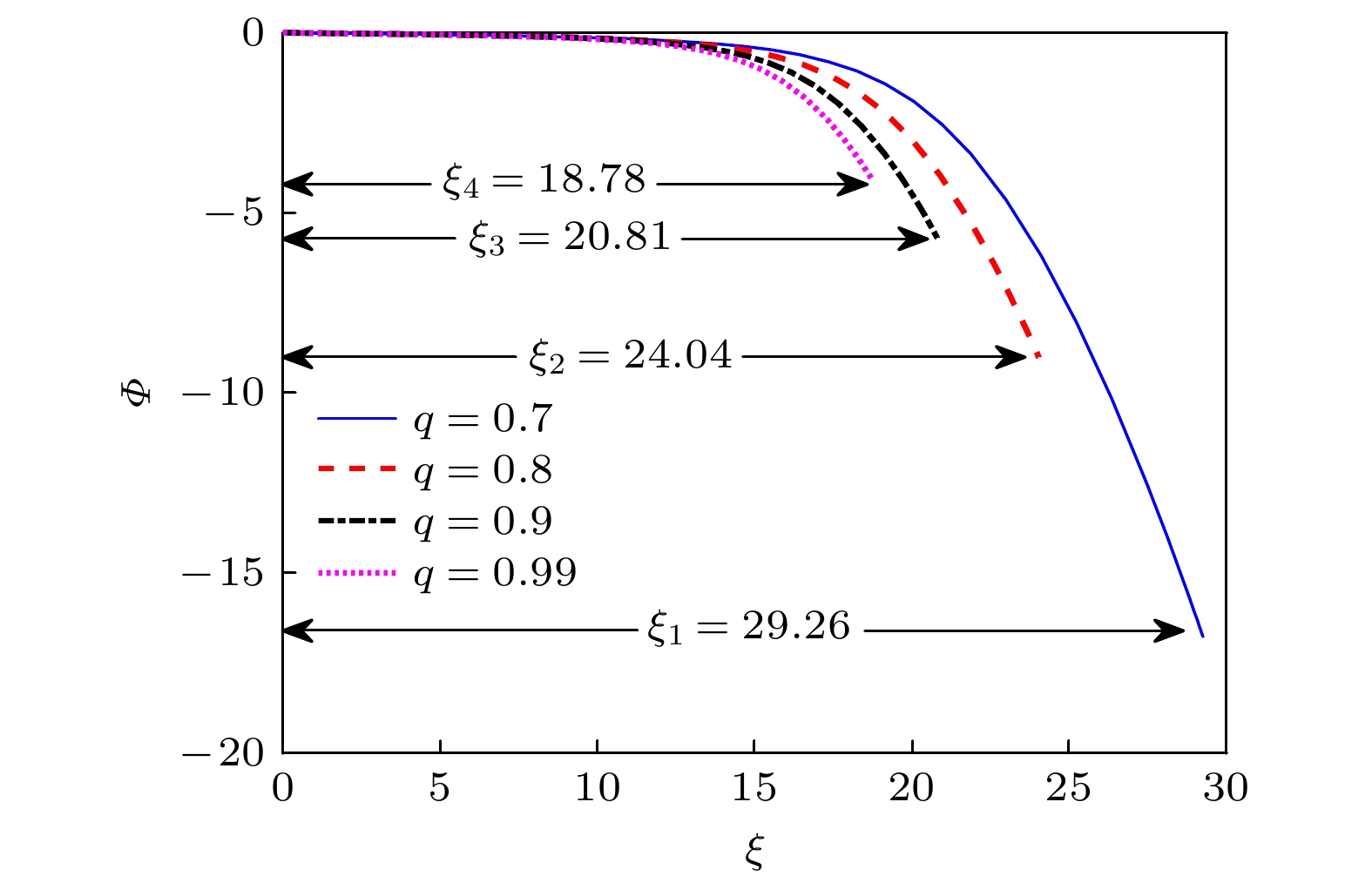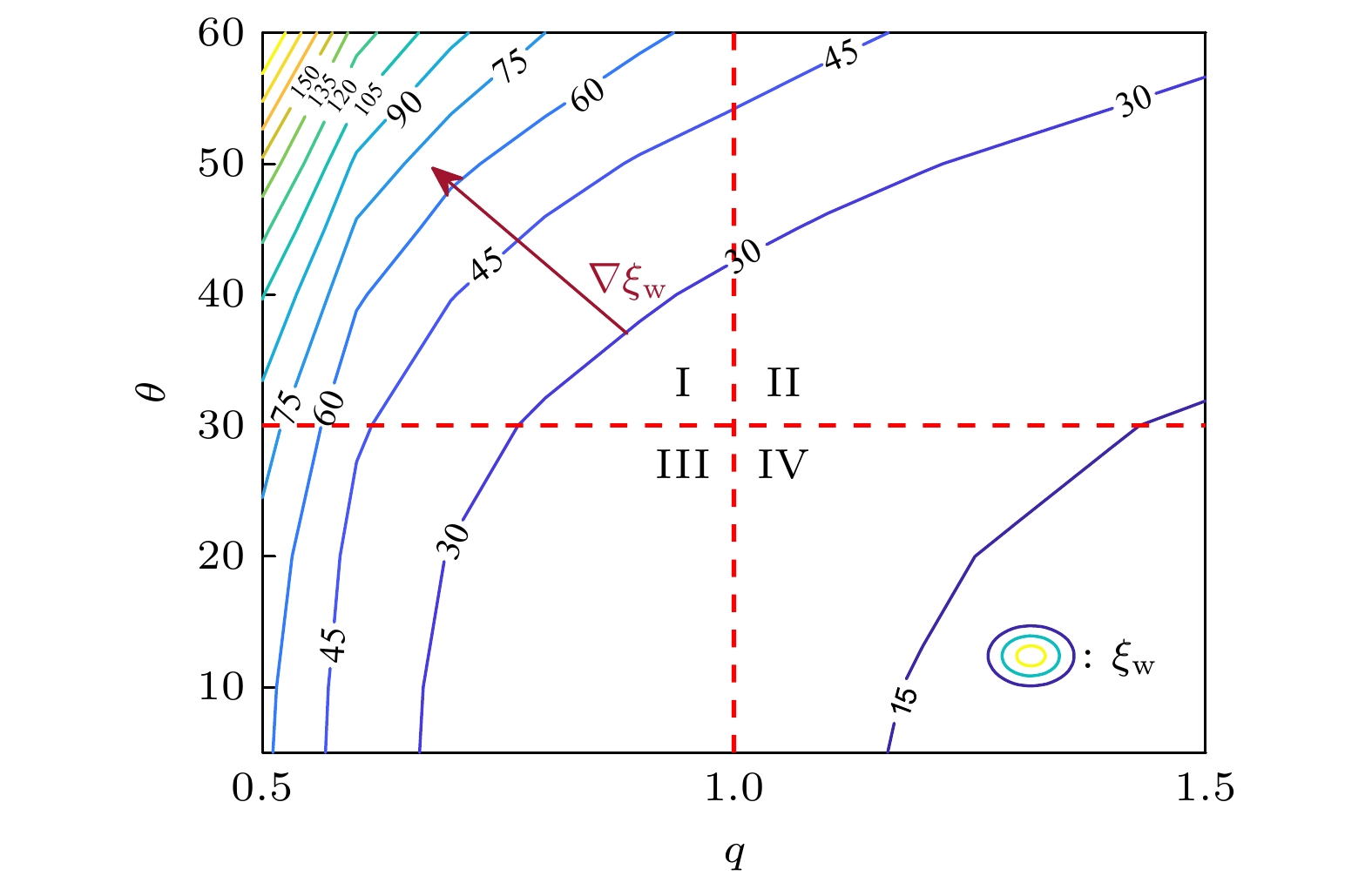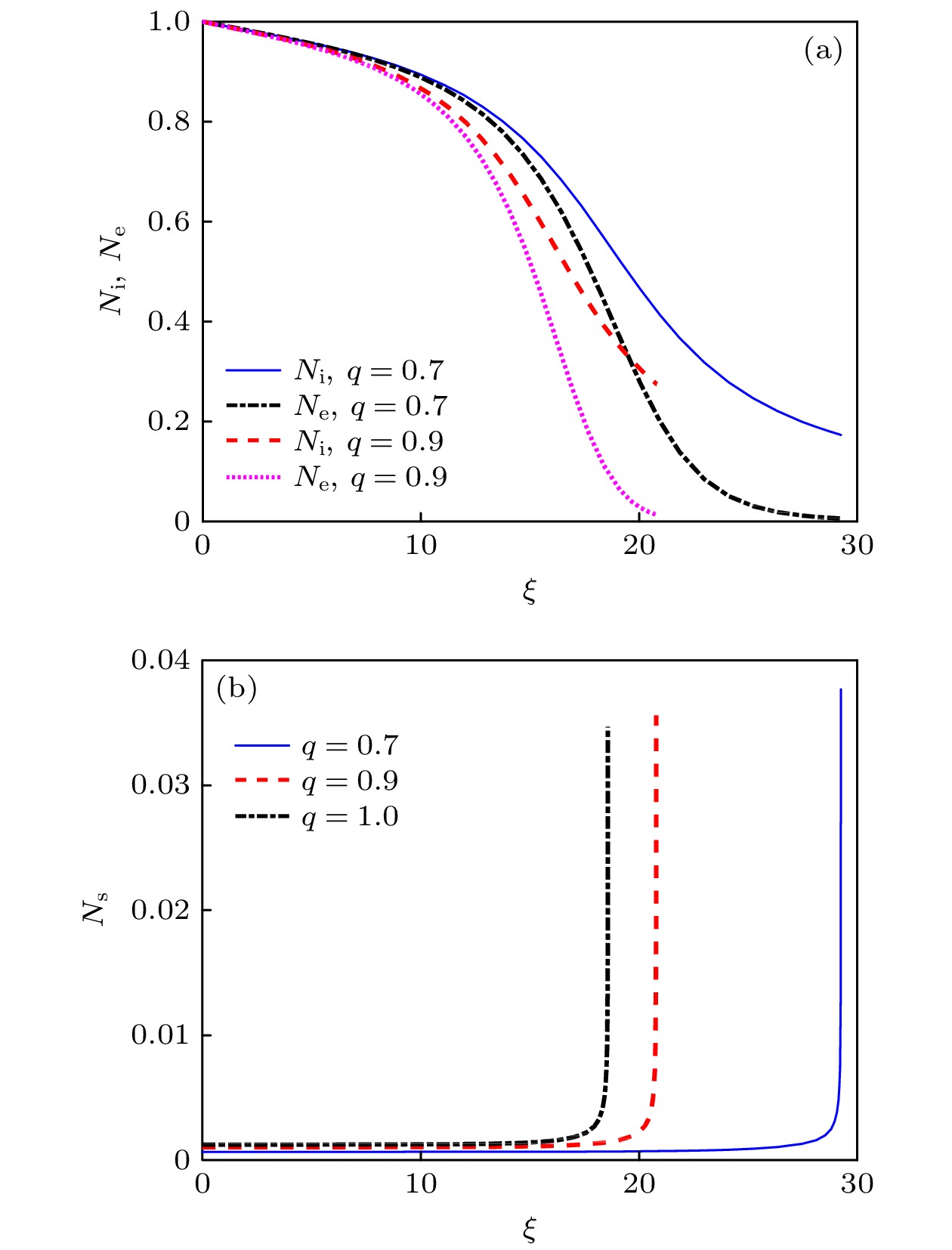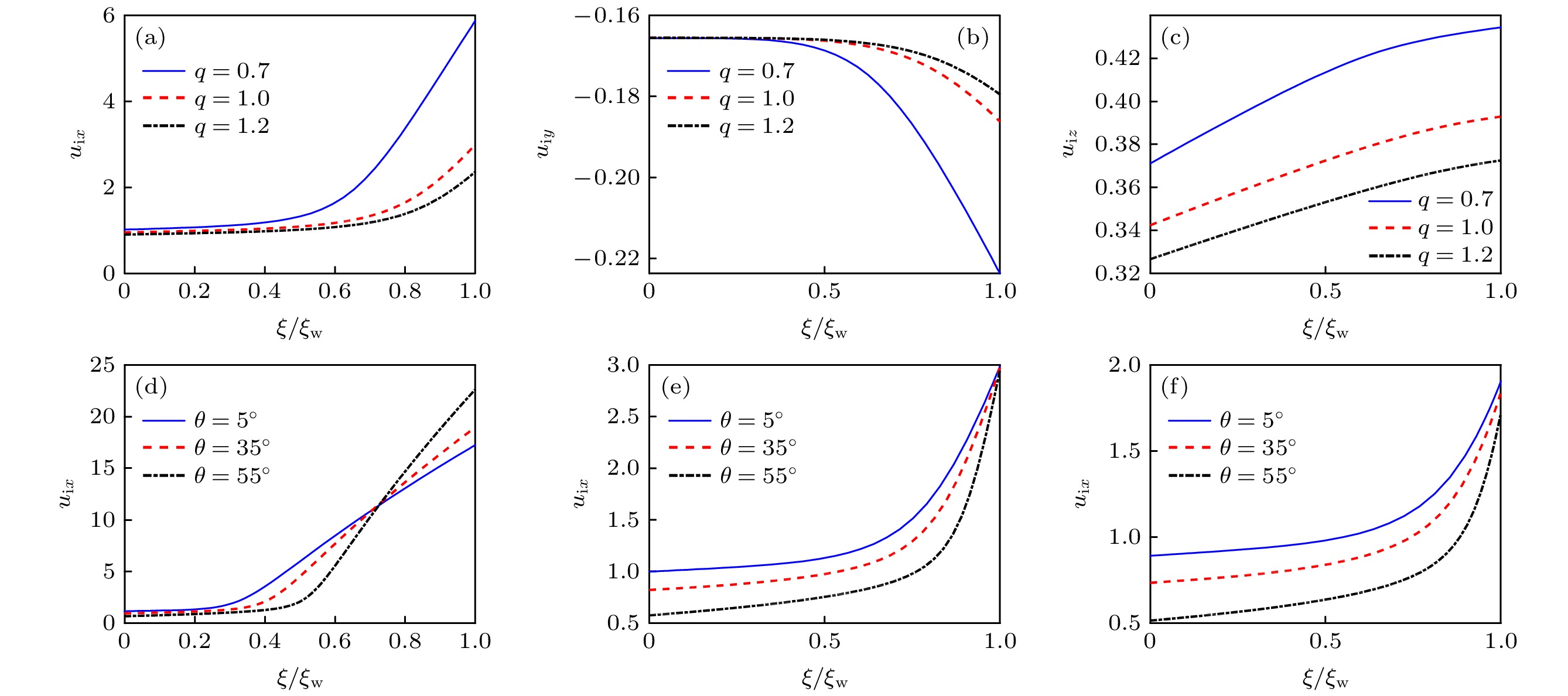-
采用空间一维速度三维的磁流体模型研究了电子的非麦克斯韦分布对具有二次电子发射的磁化等离子体鞘层特性的影响. 假设鞘层中电子速度服从非广延分布, 离子在具有一定倾斜角度的磁场中被磁化. 通过建立自洽的磁流体方程, 研究了电子非广延分布参数q及磁场强度和角度对等离子体鞘层玻姆判据、壁面悬浮电势、鞘边二次电子数密度、鞘层厚度、离子速度等的影响. 研究表明, 当电子速度分布偏离麦克斯韦分布时, 非广延参数q值越大, 玻姆判据的值越小, 壁面电势越高, 鞘边二次电子数密度增大, 鞘层厚度减小, 鞘层区域离子、电子数密度下降加快, 且壁面附近离子数密度较高, 离子3个方向的速度均降低. 此外, 随着磁场强度增大, 鞘层厚度减小, 鞘层区域离子、电子数密度下降加快; 磁场角度越大, 参数q值对壁面电势、鞘层厚度的影响程度越显著, 在超广延、亚广延分布情况下壁面附近离子x方向速度随磁场角度变化呈相反趋势.In this paper, the effects of non-Maxwellian distribution of electrons on the characteristics of magnetized plasma sheath with secondary electron emission are investigated by using a magnetic fluid model of one-dimensional velocity and three-dimensional space. The velocity of electrons follows the non-extensive distribution, and the ions are magnetized in a magnetic field with a certain tilt angle relative to the wall. The effects of the non-extensive electron distribution parameter q and the magnetic field strength and angle on the Bohm criterion, the floating wall potential, the secondary electron number density at the sheath edge, the sheath thickness and the ion velocity are studied by establishing the self-consistent equations. When the electron velocity distribution deviates from the Maxwellian distribution, the results show that as the q-parameter increases, the value of the Bohm criterion decreases, the floating wall potential increases, the number of secondary electrons at the sheath increases, the sheath thickness decreases, the number density of ions and electrons decline faster, the number density of ions near the wall is higher, and the velocities of the ions in the three directions are all reduced. In addition, as the magnetic field strength increases, the sheath thickness decreases, and the number density of ions and electrons in the sheath area decrease rapidly; the larger the magnetic field angle, the more significant the influences of the parameter q on the wall potential and the sheath thickness are, while the velocity component of the ion in the x-direction decreases with the increase of the magnetic field angle, but in the case of super-extensive distribution (q < 1), the velocity change near the wall presents an opposite trend, the increase of magnetic field angle causes wall velocity to increase; when it is close to Maxwellian distribution (q → 1), the velocity near the wall does not depend on the change of the magnetic field angle and basically tends to be identical; in the case of sub-extensive distribution (q > 1), the velocity near the wall decreases with the magnetic field angle increasing.
-
Keywords:
- non-extensive distribution /
- secondary electron emission /
- magnetized sheath /
- Bohm criterion
[1] Franklin R N 2000 J. Phys. D: Appl. Phys. 33 3186
 Google Scholar
Google Scholar
[2] Tskhakaya D D, Shukla P K, Eliasson B, Kuhn S 2005 Phys. Plasmas 12 103503
 Google Scholar
Google Scholar
[3] Shibata K, Ito H, Yugami N, Miyazaki T, Nishida Y 2001 Thin Solid Films 386 291
 Google Scholar
Google Scholar
[4] Hatami M M 2015 Phys. Plasmas 22 023506
 Google Scholar
Google Scholar
[5] Aanesland A, Rafalskyi D, Bredin J, Grondein P, Oudini N, Chabert P, Levko D, Garrigues L, Hagelaar G 2015 IEEE Trans. Plasma Sci. 43 321
 Google Scholar
Google Scholar
[6] Adhikari S, Moulick R, Goswami K S 2017 Phys. Plasmas 224 083501
 Google Scholar
Google Scholar
[7] Liu J Y, Zhang Q, Zou X, Wang Z X, Liu Y, Wang X G, Gong Y 2004 Vacuum 73 687
 Google Scholar
Google Scholar
[8] Driouch I, Chatei H, Bojaddaini M E 2015 Phys. Plasmas 81 905810104
 Google Scholar
Google Scholar
[9] Benlemdjaldi D, Tahraoui A, Hugon R, Bougdira J 2013 Phys. Plasmas 20 043508
 Google Scholar
Google Scholar
[10] 王正汹, 刘金远, 邹秀, 刘悦, 王晓刚 2004 物理学报 53 793
 Google Scholar
Google Scholar
Wang Z X, Liu J Y, Zou X, Liu Y, Wang X G 2004 Acta Phys. Sin. 53 793
 Google Scholar
Google Scholar
[11] Saslaw W C, Arp H 1986 Phys. Today 39 61
 Google Scholar
Google Scholar
[12] Cáceres M O 1999 Braz. J. Phys. 29 125
 Google Scholar
Google Scholar
[13] Tsallis C, Mendes R, Plastino A R 1998 Physica A 261 534
 Google Scholar
Google Scholar
[14] Hatami M M, Tribeche M 2018 IEEE Trans. Plasma Sci. 46 868
 Google Scholar
Google Scholar
[15] Meige A, Boswell R W 2006 Phys. Plasmas 13 92104
 Google Scholar
Google Scholar
[16] Singh H, Graves D B 2000 J. Appl. Phys. 88 3889
 Google Scholar
Google Scholar
[17] Tsallis C 1988 J. Stat. Phys. 52 479
 Google Scholar
Google Scholar
[18] Borgohain D R, Saharia K, Goswami K S 2016 Phys. Plasmas 23 122113
 Google Scholar
Google Scholar
[19] Driouch I, Chatei H 2017 Eur. Phys. J. D. 71 1
 Google Scholar
Google Scholar
[20] Hatami M M, Tribeche M, Mamun A A 2018 Phys. Plasmas 25 094502
 Google Scholar
Google Scholar
[21] Hatami M M, Tribeche M, Mamun A A 2019 Astrophysics Space Sci. 364 1
 Google Scholar
Google Scholar
[22] Zhao X Y, Zhang B K, Wang C X 2020 Phys. Plasmas 27 113705
 Google Scholar
Google Scholar
[23] Safa N N, Ghomi H, Niknam A R 2014 Phys. Plasmas 21 082111
 Google Scholar
Google Scholar
[24] Basnet S, Khanal R 2019 Phys. Plasmas 26 043516
 Google Scholar
Google Scholar
[25] Zou X, Liu H P, Zhu Y Z, Zang X N, Qiu M H 2020 Plasmas Sci. Technol. 22 125001
 Google Scholar
Google Scholar
[26] Dhawan R, Kumar M, Malik H K 2020 Phys. Plasmas 27 063515
 Google Scholar
Google Scholar
[27] Basnet S, Patel A, Khanal R 2020 Plasma Phys. Control. Fusion 62 115011
 Google Scholar
Google Scholar
[28] 赵晓云, 张丙开, 王春晓, 唐义甲 2019 物理学报 68 185204
 Google Scholar
Google Scholar
Zhao X Y, Zhang B K, Wang C X, Tang Y J 2019 Acta Phys. Sin. 68 185204
 Google Scholar
Google Scholar
[29] Ghani O E, Driouch I, Chatei H 2020 Phys. Plasmas 27 083701
 Google Scholar
Google Scholar
[30] 邹秀, 刘惠平, 张小楠, 邱明辉 2021 物理学报 70 015201
 Google Scholar
Google Scholar
Zou X, Liu H P, Zhang X N, Qiu M H 2021 Acta Phys. Sin. 70 015201
 Google Scholar
Google Scholar
[31] Dhawan R, Malik H K 2021 Plasmas Sci. Technol. 23 045402
 Google Scholar
Google Scholar
[32] Bezerra J R, Silva R, Lima J A S 2003 Physica A 322 256
 Google Scholar
Google Scholar
[33] Safa N N, Ghomi H, Niknam A R 2015 Phys. Plasmas 81 905810303
 Google Scholar
Google Scholar
[34] Borgohain D R, Saharia K 2018 Phys. Plasmas 25 032122
 Google Scholar
Google Scholar
[35] Tribeche M, Djebarni L, Amour R 2010 Phys. Plasmas 17 042114
 Google Scholar
Google Scholar
[36] Hatami M M 2015 Phys. Plasmas 22 013508
 Google Scholar
Google Scholar
[37] Chen F F 1974 Introduction to Plasma Physics (New York: Springer Science)
-
图 4 壁面电势随非广延参数q的变化 (a)不同
$ \gamma, \theta $ 对$ {\varPhi }_{\mathrm{w}} $ 的影响; (b)不同等离子体种类对$ {\varPhi }_{\mathrm{w}}$ 的影响Fig. 4. Wall potential versus non-extensive parameter q: (a) The
$ {\varPhi }_{\mathrm{w}}$ for different values of$ \gamma, \theta $ ; (b) the$ {\varPhi }_{\mathrm{w}}$ for different kinds of plasma.图 5 鞘边二次电子数密度随非广延参数q的变化 (a)不同
$ \gamma, \theta $ 下鞘边二次电子数密度分布; (b)不同等离子体种类下鞘边二次电子数密度分布Fig. 5. Normalized density of secondary electrons at the sheath edge versus non-extensive parameter q: (a) Density of secondary electrons at the sheath edge for different values of
$ \gamma \; \mathrm{a}\mathrm{n}\mathrm{d} \; \theta $ ; (b) density of secondary electrons at the sheath edge for different kinds of plasma.图 8 非广延参数q值对鞘层粒子数密度分布的影响 (
$B=0.04 \; \mathrm{T}, \;\theta ={20}\text{°}, \;\gamma =0.5$ ) (a)离子、电子数密度分布; (b)二次电子数密度分布Fig. 8. Influence of the non-extensive parameter q on the particle number density distribution of the sheath (B = 0.04 T,
$ \theta ={20}\text{°},\; \gamma =0.5$ ): (a) Normalized density of ions and electrons distribution; (b) normalized density of secondary electrons distribution.图 9 磁场对鞘层离子、电子数密度分布的影响(
$ q=0.8, \gamma =0.5 $ ) (a) 磁场大小的影响; (b)磁场角度的影响Fig. 9. Influence of magnetic field on the number density distribution of sheath ions and electrons (
$ q=0.8, \gamma =0.5 $ ): (a) Variation of normalized particle density for different values of magnetic field strength; (b) variation of normalized particle density for different values of magnetic field angle.图 10 (a)−(c)非广延参数q值和(d)−(f)磁场角度对离子速度的影响(
$ B=0.04 \; \mathrm{T}, \gamma =0.5 $ ) (a) x方向速度($\theta ={20}\text{°}$ ); (b) y方向速度($\theta ={20}\text{°}$ ); (c) z方向速度($\theta ={20}\text{°}$ ); (d) x方向速度, q = 0.5; (e) x方向速度, q = 1; (f) x方向速度, q = 1.5Fig. 10. Influence of (a)−(c) non-extensive parameter q value and (d)−(f) magnetic field angle on ion velocity (
$ B=0.04 \; \mathrm{T}, \gamma =0.5 $ ): (a) x-component ($\theta ={20}\text{°}$ ); (b) y-component ($\theta ={20}\text{°}$ ); (c) z-component ($\theta ={20}\text{°}$ ); (d) x-component, q = 0.5; (e) x-component, q = 1; (f) x-component, q = 1.5. -
[1] Franklin R N 2000 J. Phys. D: Appl. Phys. 33 3186
 Google Scholar
Google Scholar
[2] Tskhakaya D D, Shukla P K, Eliasson B, Kuhn S 2005 Phys. Plasmas 12 103503
 Google Scholar
Google Scholar
[3] Shibata K, Ito H, Yugami N, Miyazaki T, Nishida Y 2001 Thin Solid Films 386 291
 Google Scholar
Google Scholar
[4] Hatami M M 2015 Phys. Plasmas 22 023506
 Google Scholar
Google Scholar
[5] Aanesland A, Rafalskyi D, Bredin J, Grondein P, Oudini N, Chabert P, Levko D, Garrigues L, Hagelaar G 2015 IEEE Trans. Plasma Sci. 43 321
 Google Scholar
Google Scholar
[6] Adhikari S, Moulick R, Goswami K S 2017 Phys. Plasmas 224 083501
 Google Scholar
Google Scholar
[7] Liu J Y, Zhang Q, Zou X, Wang Z X, Liu Y, Wang X G, Gong Y 2004 Vacuum 73 687
 Google Scholar
Google Scholar
[8] Driouch I, Chatei H, Bojaddaini M E 2015 Phys. Plasmas 81 905810104
 Google Scholar
Google Scholar
[9] Benlemdjaldi D, Tahraoui A, Hugon R, Bougdira J 2013 Phys. Plasmas 20 043508
 Google Scholar
Google Scholar
[10] 王正汹, 刘金远, 邹秀, 刘悦, 王晓刚 2004 物理学报 53 793
 Google Scholar
Google Scholar
Wang Z X, Liu J Y, Zou X, Liu Y, Wang X G 2004 Acta Phys. Sin. 53 793
 Google Scholar
Google Scholar
[11] Saslaw W C, Arp H 1986 Phys. Today 39 61
 Google Scholar
Google Scholar
[12] Cáceres M O 1999 Braz. J. Phys. 29 125
 Google Scholar
Google Scholar
[13] Tsallis C, Mendes R, Plastino A R 1998 Physica A 261 534
 Google Scholar
Google Scholar
[14] Hatami M M, Tribeche M 2018 IEEE Trans. Plasma Sci. 46 868
 Google Scholar
Google Scholar
[15] Meige A, Boswell R W 2006 Phys. Plasmas 13 92104
 Google Scholar
Google Scholar
[16] Singh H, Graves D B 2000 J. Appl. Phys. 88 3889
 Google Scholar
Google Scholar
[17] Tsallis C 1988 J. Stat. Phys. 52 479
 Google Scholar
Google Scholar
[18] Borgohain D R, Saharia K, Goswami K S 2016 Phys. Plasmas 23 122113
 Google Scholar
Google Scholar
[19] Driouch I, Chatei H 2017 Eur. Phys. J. D. 71 1
 Google Scholar
Google Scholar
[20] Hatami M M, Tribeche M, Mamun A A 2018 Phys. Plasmas 25 094502
 Google Scholar
Google Scholar
[21] Hatami M M, Tribeche M, Mamun A A 2019 Astrophysics Space Sci. 364 1
 Google Scholar
Google Scholar
[22] Zhao X Y, Zhang B K, Wang C X 2020 Phys. Plasmas 27 113705
 Google Scholar
Google Scholar
[23] Safa N N, Ghomi H, Niknam A R 2014 Phys. Plasmas 21 082111
 Google Scholar
Google Scholar
[24] Basnet S, Khanal R 2019 Phys. Plasmas 26 043516
 Google Scholar
Google Scholar
[25] Zou X, Liu H P, Zhu Y Z, Zang X N, Qiu M H 2020 Plasmas Sci. Technol. 22 125001
 Google Scholar
Google Scholar
[26] Dhawan R, Kumar M, Malik H K 2020 Phys. Plasmas 27 063515
 Google Scholar
Google Scholar
[27] Basnet S, Patel A, Khanal R 2020 Plasma Phys. Control. Fusion 62 115011
 Google Scholar
Google Scholar
[28] 赵晓云, 张丙开, 王春晓, 唐义甲 2019 物理学报 68 185204
 Google Scholar
Google Scholar
Zhao X Y, Zhang B K, Wang C X, Tang Y J 2019 Acta Phys. Sin. 68 185204
 Google Scholar
Google Scholar
[29] Ghani O E, Driouch I, Chatei H 2020 Phys. Plasmas 27 083701
 Google Scholar
Google Scholar
[30] 邹秀, 刘惠平, 张小楠, 邱明辉 2021 物理学报 70 015201
 Google Scholar
Google Scholar
Zou X, Liu H P, Zhang X N, Qiu M H 2021 Acta Phys. Sin. 70 015201
 Google Scholar
Google Scholar
[31] Dhawan R, Malik H K 2021 Plasmas Sci. Technol. 23 045402
 Google Scholar
Google Scholar
[32] Bezerra J R, Silva R, Lima J A S 2003 Physica A 322 256
 Google Scholar
Google Scholar
[33] Safa N N, Ghomi H, Niknam A R 2015 Phys. Plasmas 81 905810303
 Google Scholar
Google Scholar
[34] Borgohain D R, Saharia K 2018 Phys. Plasmas 25 032122
 Google Scholar
Google Scholar
[35] Tribeche M, Djebarni L, Amour R 2010 Phys. Plasmas 17 042114
 Google Scholar
Google Scholar
[36] Hatami M M 2015 Phys. Plasmas 22 013508
 Google Scholar
Google Scholar
[37] Chen F F 1974 Introduction to Plasma Physics (New York: Springer Science)
计量
- 文章访问数: 6887
- PDF下载量: 94
- 被引次数: 0













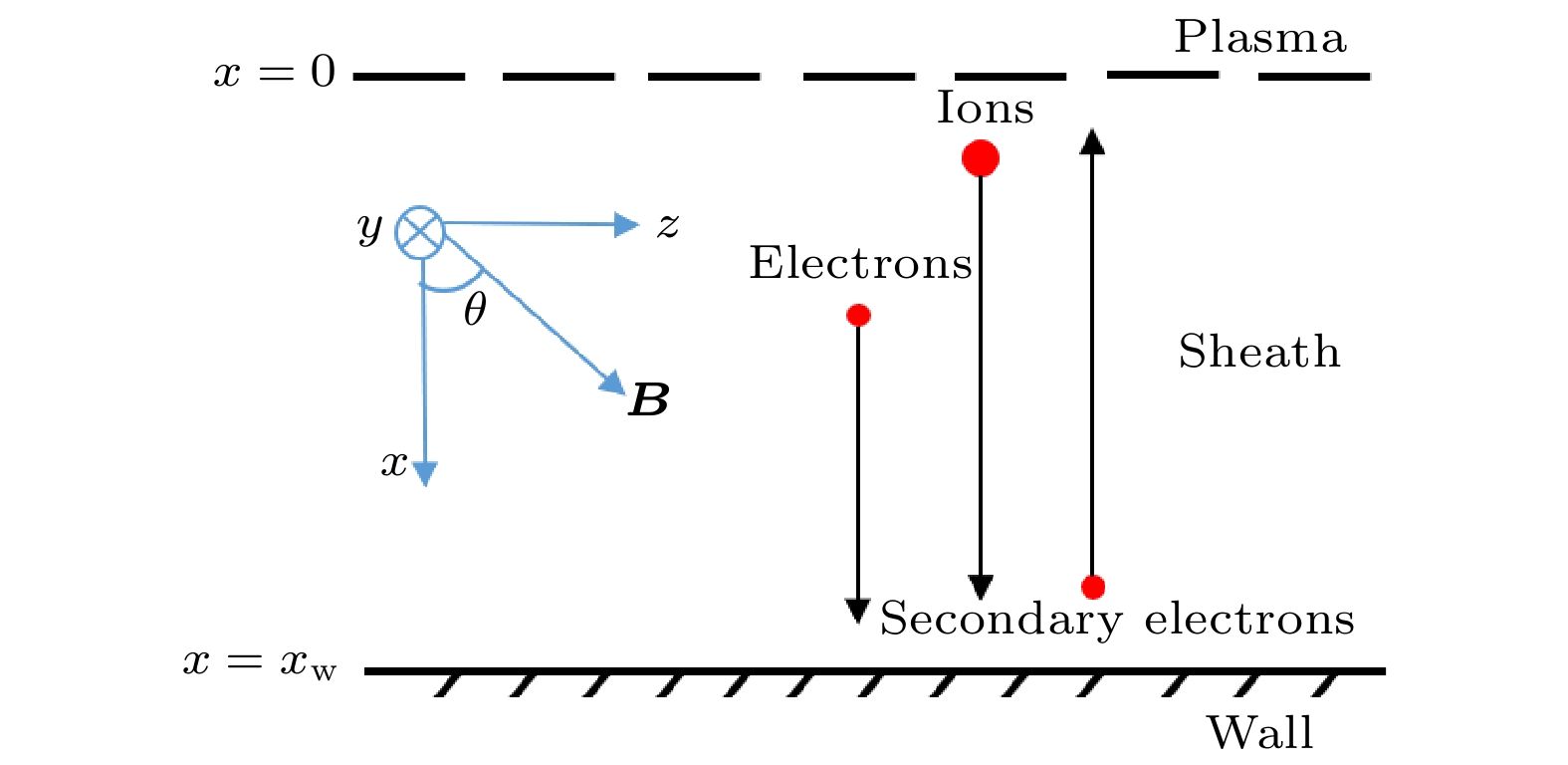
 下载:
下载:












